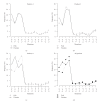Features of recent codon evolution: a comparative polymorphism-fixation study
- PMID: 20622912
- PMCID: PMC2896653
- DOI: 10.1155/2010/202918
Features of recent codon evolution: a comparative polymorphism-fixation study
Abstract
Features of amino-acid and codon changes can provide us important insights on protein evolution. So far, investigators have often examined mutation patterns at either interspecies fixed substitution or intraspecies nucleotide polymorphism level, but not both. Here, we performed a unique analysis of a combined set of intra-species polymorphisms and inter-species substitutions in human codons. Strong difference in mutational pattern was found at codon positions 1, 2, and 3 between the polymorphism and fixation data. Fixation had strong bias towards increasing the rarest codons but decreasing the most frequently used codons, suggesting that codon equilibrium has not been reached yet. We detected strong CpG effect on CG-containing codons and subsequent suppression by fixation. Finally, we detected the signature of purifying selection against Amid R:U dinucleotides at synonymous dicodon boundaries. Overall, fixation process could effectively and quickly correct the volatile changes introduced by polymorphisms so that codon changes could be gradual and directional and that codon composition could be kept relatively stable during evolution.
Figures




Similar articles
-
Codon Usage Selection Can Bias Estimation of the Fraction of Adaptive Amino Acid Fixations.Mol Biol Evol. 2016 Jun;33(6):1580-9. doi: 10.1093/molbev/msw027. Epub 2016 Feb 12. Mol Biol Evol. 2016. PMID: 26873577
-
Adaptive evolution in humans revealed by the negative correlation between the polymorphism and fixation phases of evolution.Proc Natl Acad Sci U S A. 2007 Mar 6;104(10):3907-12. doi: 10.1073/pnas.0605565104. Epub 2007 Feb 26. Proc Natl Acad Sci U S A. 2007. PMID: 17360451 Free PMC article.
-
Evaluation of the effect of CpG hypermutability on human codon substitution.Gene. 2009 Feb 15;431(1-2):18-22. doi: 10.1016/j.gene.2008.11.006. Epub 2008 Nov 19. Gene. 2009. PMID: 19059467
-
Molecular evolution of synonymous codon usage in Populus.BMC Evol Biol. 2008 Nov 4;8:307. doi: 10.1186/1471-2148-8-307. BMC Evol Biol. 2008. PMID: 18983655 Free PMC article.
-
New insights into the factors affecting synonymous codon usage in human infecting Plasmodium species.Acta Trop. 2017 Dec;176:29-33. doi: 10.1016/j.actatropica.2017.07.025. Epub 2017 Jul 24. Acta Trop. 2017. PMID: 28751162 Review.
Cited by
-
Advantages of an easy-to-use DNA extraction method for minimal-destructive analysis of collection specimens.PLoS One. 2020 Jul 8;15(7):e0235222. doi: 10.1371/journal.pone.0235222. eCollection 2020. PLoS One. 2020. PMID: 32639972 Free PMC article.
-
RNA encodes physical information.bioRxiv [Preprint]. 2024 Dec 12:2024.12.11.627970. doi: 10.1101/2024.12.11.627970. bioRxiv. 2024. PMID: 39713325 Free PMC article. Preprint.
References
-
- Brooks DJ, Fresco JR, Lesk AM, Singh M. Evolution of amino acid frequencies in proteins over deep time: inferred order of introduction of amino acids into the genetic code. Molecular Biology and Evolution. 2002;19(10):1645–1655. - PubMed
-
- Trifonov EN. The triplet code from first principles. Journal of Biomolecular Structure and Dynamics. 2004;22(1):1–11. - PubMed
-
- Miller SL. A production of amino acids under possible primitive earth conditions. Science. 1953;117(3046):528–529. - PubMed
-
- Brooks DJ, Fresco JR. Increased frequency of cysteine, tyrosine, and phenylalanine residues since the last universal ancestor. Molecular & Cellular Proteomics. 2002;1(2):125–131. - PubMed
-
- Jordan IK, Kondrashov FA, Adzhubei IA, et al. A universal trend of amino acid gain and loss in protein evolution. Nature. 2005;433(7026):633–638. - PubMed
Publication types
MeSH terms
Substances
Grants and funding
LinkOut - more resources
Full Text Sources

